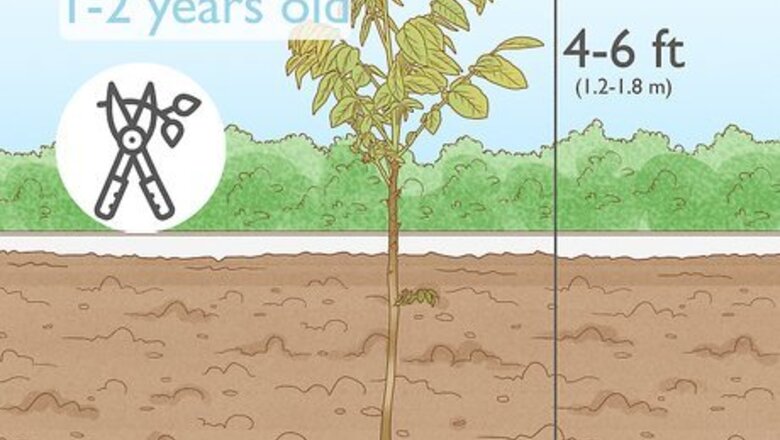
views
Training Young Trees
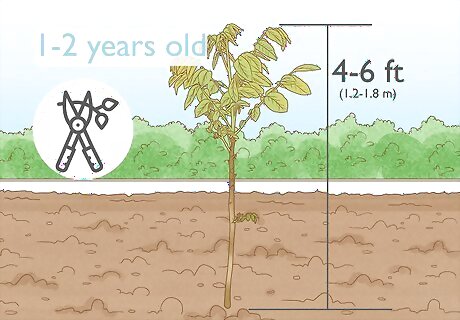
Prune the tree when it is 1-2 years old into the central leader position. After about 1-2 years of growth, your walnut tree should have its basic form. It should have several moderately thick branches and be roughly 4–6 ft (1.2–1.8 m) tall. At this point, you can begin shaping the tree into the central leader position. The central leader position typically has 1 main trunk with about 5 branches on the side. The central leader position is based off the natural growth of the tree, focusing on a main leader branch that keeps the canopy of the tree open to light and air circulation. The central leader helps supply nutrients to the large, fruit bearing branches so the tree grows as many walnuts as possible.
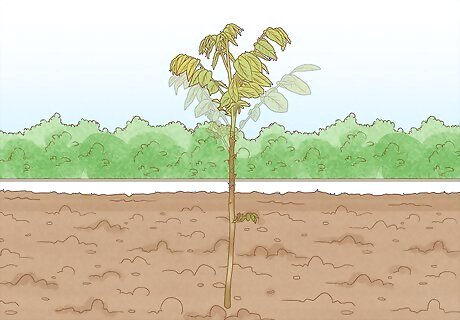
Leave 1 main branch at the top of your tree and remove the rest. The branch at the very top is your “central leader,” which keeps the top of your tree open and airy. If you see additional branches growing towards the top, snip them off with garden shears or saw them away using a hand saw. This way, your tree can direct all its nutrients to this topmost branch.

Remove branches thicker than ⅓ of your trunk’s thickness. When pruning walnut trees, observe the "3-to-1 rule." Examine the thickness of your trunk, and use this as a guide when deciding which branches to keep and which to remove. If you find a branch larger than ⅓ of the trunk's diameter, cut it off at a 45-degree angle. This way, your branches will all receive a balanced amount of nutrients and grow healthy and strong. If your tree has more than 1 thick branch, then it will be harder for the other branches to grow and develop walnuts. If you keep branches that are on the thicker side, they can unevenly drain the nutrients from the tree and grow too thick.
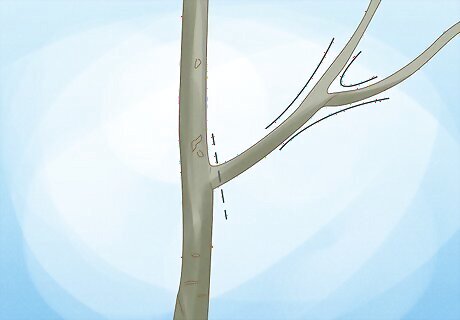
Cut off any forked branches either into a single shoot or at the trunk. A forked branch is a shoot with a split in the branch, causing 2 branches to grow from the main branch. These branches require more nutrients from the tree, and they often act as leeches from the other branches receiving vital nutrients. To prevent this, you can either cut off 1 side of the branch to make a single shoot, or you can cut off the branch entirely. Both options will help your tree better conserve nutrients. If you already have many adequate branches, you may want to simply remove the branch completely. If you have a few sparse branches, trim off the smaller of the forked sides.
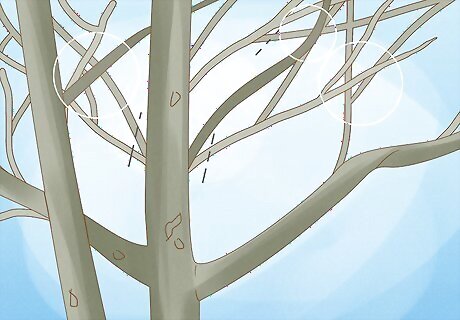
Trim off branches that cross or rub together to keep your tree healthy. Inspect the framework of your tree, and look for any branches that have intersecting paths or touch together. These branches are cosmetically unattractive, and they often make the inner skeleton of your tree bulky and hard to access. As a result, your tree may not grow as many walnuts. To prevent this, cut off these branches where they meet the trunk of the tree. This way, your tree only grows outward-facing, healthy branches. This keeps the tree invigorated, so it can put more energy into fewer branches.
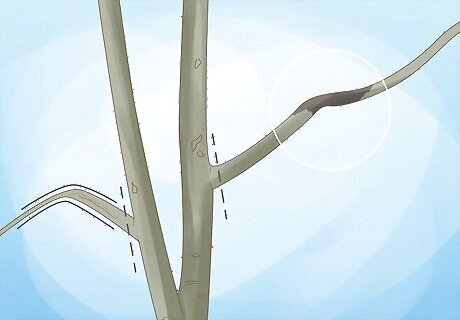
Remove any low-hanging and damaged branches to shape your tree. Cut off any branches that are below 4–5 ft (1.2–1.5 m) or so. Low-hanging branches take away from the rounded look of your tree. In addition, get rid of any discolored or thin branches. Small and damaged branches drain nutrients from your tree. Cut your branches at a 45-degree angle so you minimally damage the tree. These branches take away from the overall look and shape of the tree, and since they are not very strong, they likely will not grow walnuts.
Pruning Mature Trees

Prune mature trees once every 3-5 years to preserve their shape. When pruning young trees, you create the shape and structure of the tree for its entire life. Your later prunings are to maintain the structure and polish up the appearance of your tree. To do this, look for any new, fresh branches and cut them off with your garden shears.
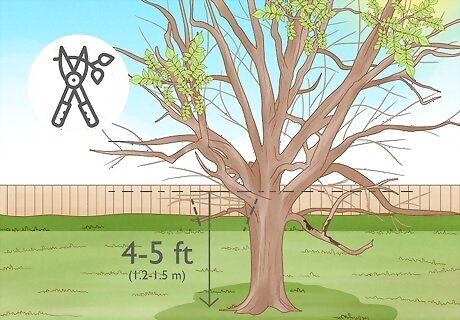
Cut off low or damaged branches to maintain the central leader shape. Just like you did when pruning your young trees, inspect your trees for branches below 4–5 ft (1.2–1.5 m), and look for any damaged branches or discolored areas. If you find any low-hanging or sickly branches, cut them off at a 45-degree angle near the trunk. This keeps your tree healthy as it continues to grow and produce walnuts. You can use your garden shears, as these branches shouldn’t be very thick.
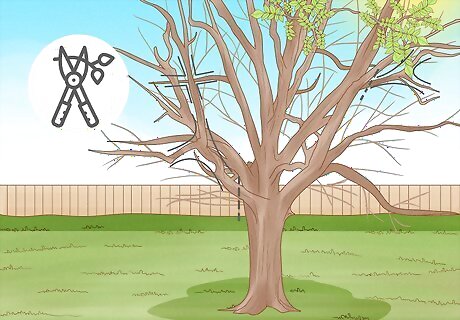
Remove any forked or crossing branches to keep your tree healthy. As new branches grow, they may take a forked appearance or may start to grow across one another. If you notice any forked or crossed branches, cut them off using your garden shears or hand saw. Make your cut as close to the trunk of the tree as you can, and use a 45-degree angle as you cut. If you’d like, you can remove the smaller of the forked branches and keep the larger section. Do this if the branch is towards the top middle of the tree and if it looks attractive.
Deciding on Tools
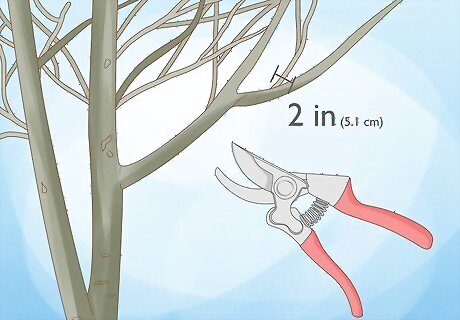
Use garden shears to cut branches up to 2 in (5.1 cm) thick. When trimming thin branches, you can easily use a pair of garden shears. Do this if the branch is about ⁄2–2 in (1.3–5.1 cm). To cut, simply place your shears where the branch meets the trunk and make your snip. Garden shears are small, handheld tools used to cut off branches or stems. Before you start, disinfect your tools with a diluted bleach solution or rubbing alcohol. This will help prevent the spread of disease.
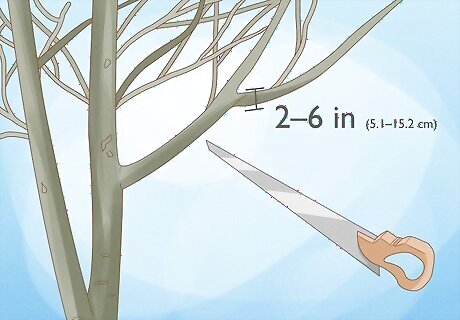
Remove branches with a hand saw if they are 2–6 in (5.1–15.2 cm) thick. If your tree has branches between 2–4 in (5.1–10.2 cm) thick, a hand saw works well to chop off your branches. Position the saw where the branch meets the tree trunk, and quickly move it back and forth until the branch falls off. If you use gardening shears on thick branches, you can injure yourself or the tree. It will also damage your gardening shears. When using the saw, keep the blade away from your body to prevent injuries. Be careful with falling branches. Before you make cuts, plan how they will fall, making sure they won't damage structures, vehicles, or outdoor items. Additionally, people should be at a safe distance to avoid injury.
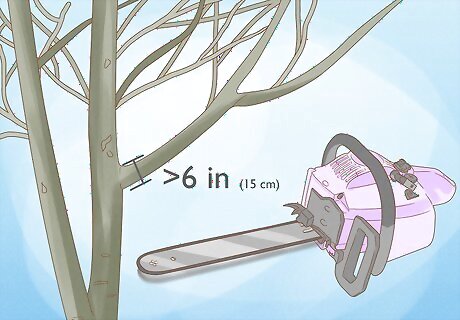
Use a chainsaw to remove large, thick branches over 6 in (15 cm) thick. If you are removing large branches from mature trees, the safest option is to use a chainsaw. Hold the chainsaw firmly, and bring it straight down through the branch to make your cut. Be sure the ground is clear beneath the branch so it does not damage anything or anyone as it falls. Wear safety goggles, hold the chainsaw away from your body, and handle the chainsaw with care to keep yourself protected. Ask a spotter to help you cut the branch. Before you start cutting, plan an escape route in case things go wrong. You need to be able to escape the falling branch. If you are not experienced with a chainsaw, hiring a professional may be a safer option.
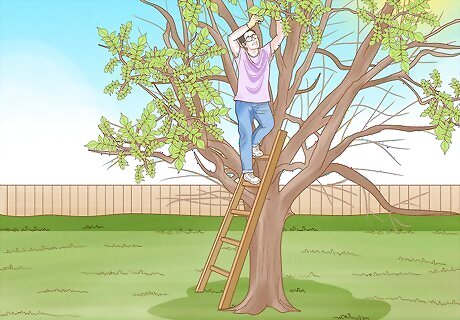
Climb a ladder or forklift to help you reach branches on tall trees. If you are trimming branches from mature trees, it may be difficult to reach the branches high above. Set up a full-size ladder next to the tree, and climb up with your tool to get rid of your branches. If your tree is extremely tall, rent a forklift from a home supply store, follow all operational directions, and use the forklift to access the top of your tree. Always have someone spot you in case of injuries. Do this if you are comfortable with heights and experienced with using similar tools and equipment. If you are not familiar with heavy machinery or landscaping equipment, it may be safer to hire a professional arborist.
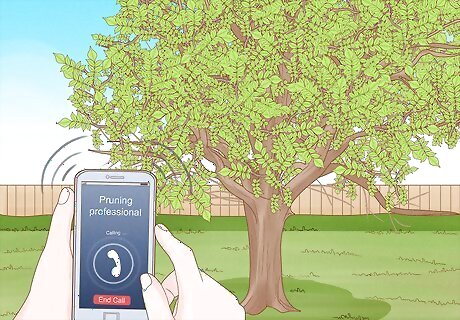
Hire a professional if you have a very large walnut tree. Pruning large trees takes precision, sharp tools, and the ability to reach high above. If you have a large walnut tree and cannot reach the top, your safest option may be to hire a professional. To do this, search online for “Hire tree cutter” or “Local arborist companies,” and browse your options. Then, contact the company and discuss your pruning needs and tree height. The arborist can come and trim your trees safely for you, so you don’t have to worry about hurting yourself or harming the tree. This is a great idea if you aren’t very familiar with pruning walnut trees or are afraid of heights. While it is not hard to prune walnut trees, it can be difficult to access the top of the tree. For best results, consider hiring a professional after your branches reach 3 in (7.6 cm) or more in diameter.


















Comments
0 comment